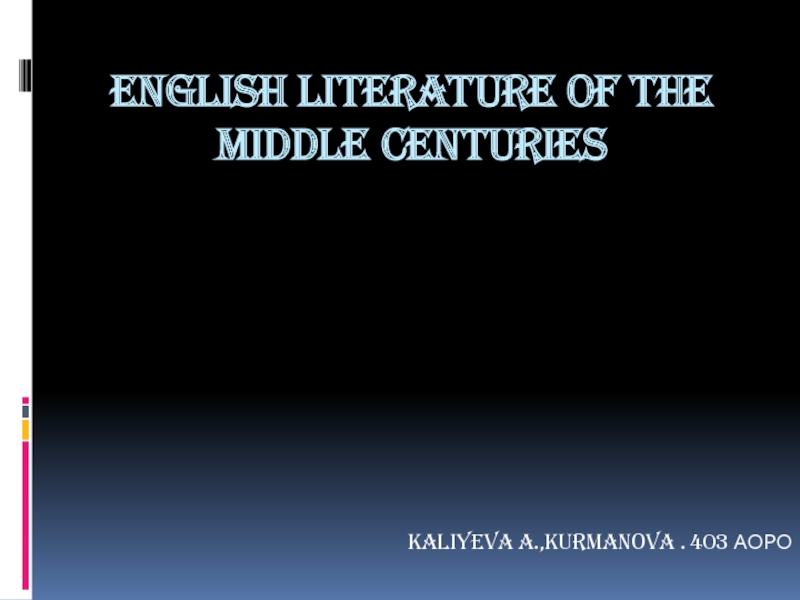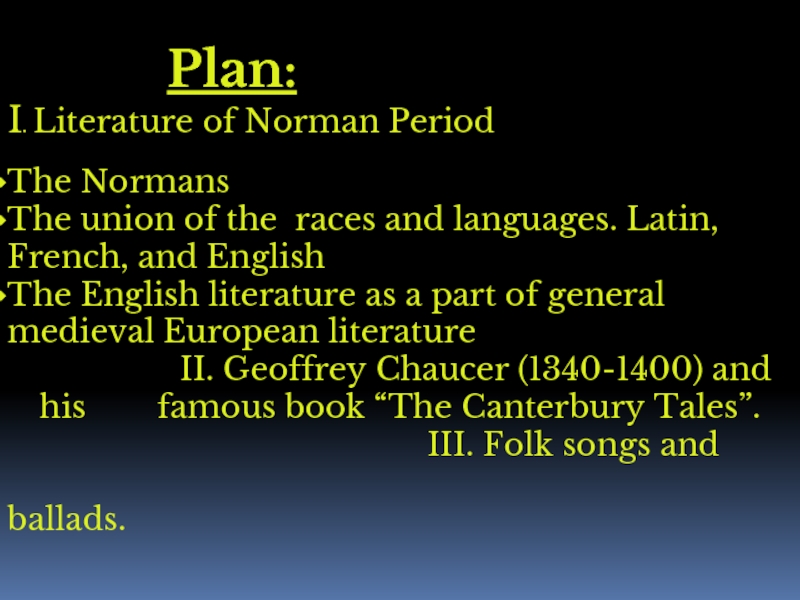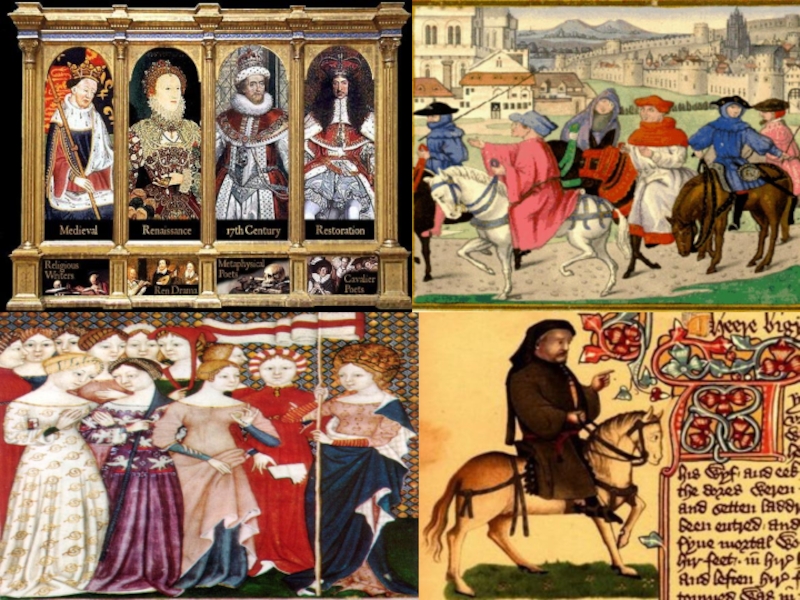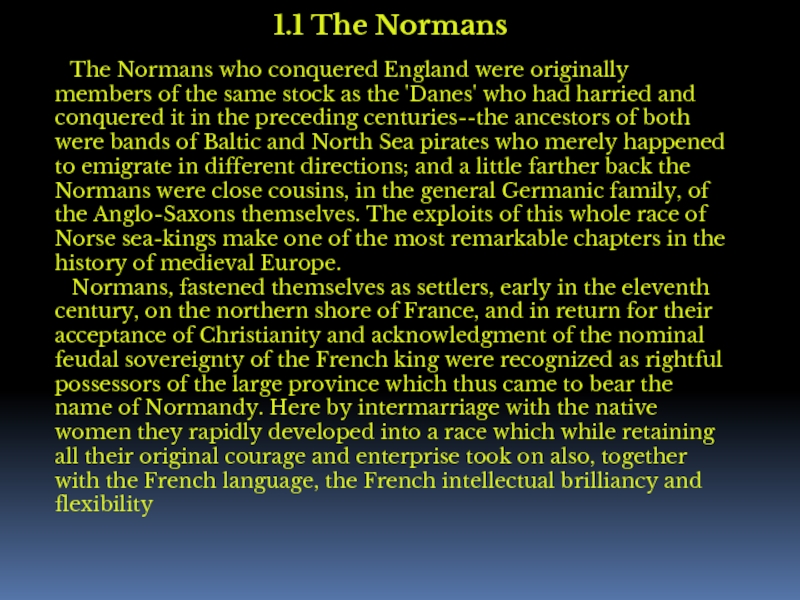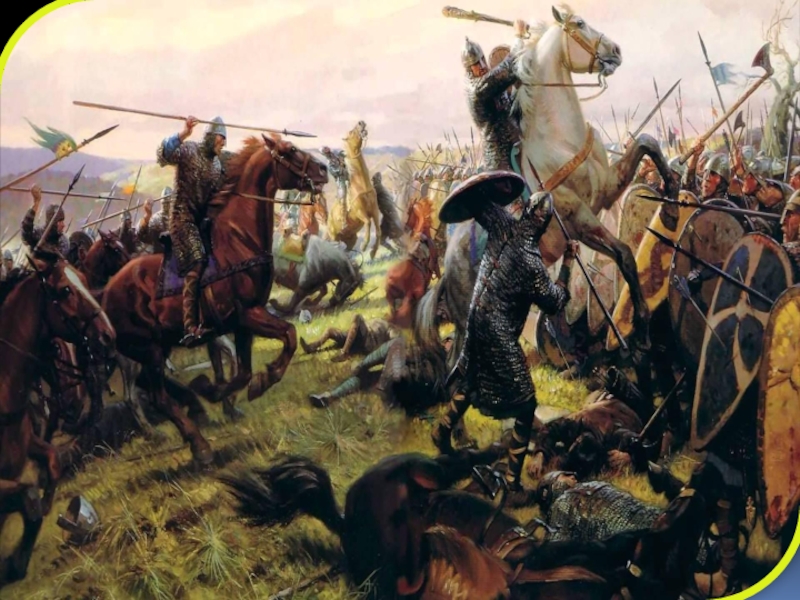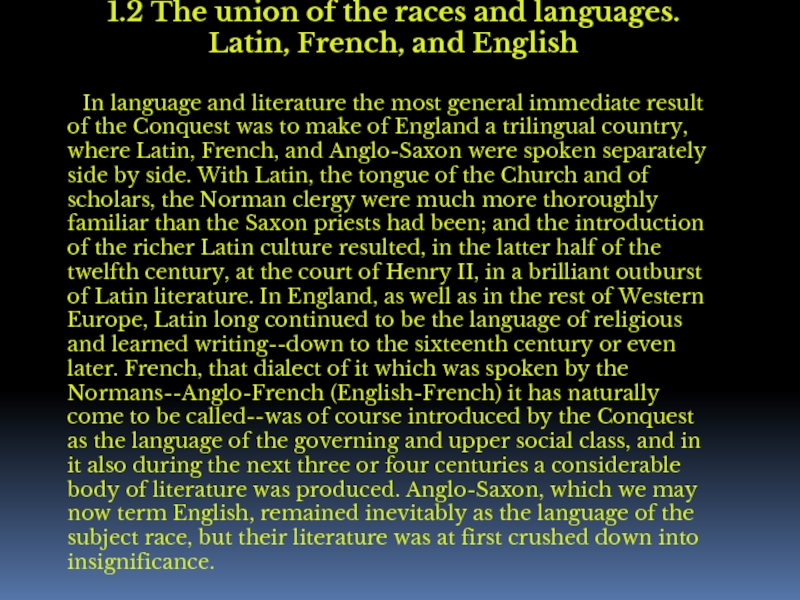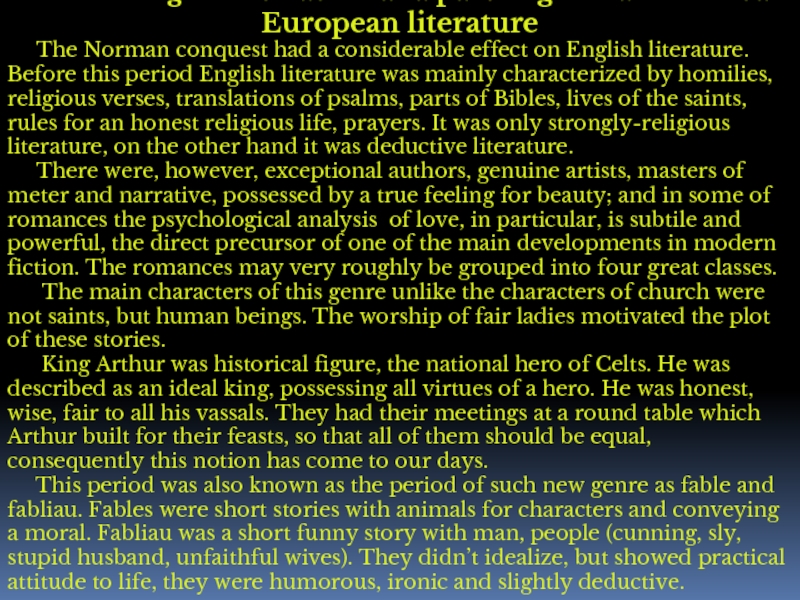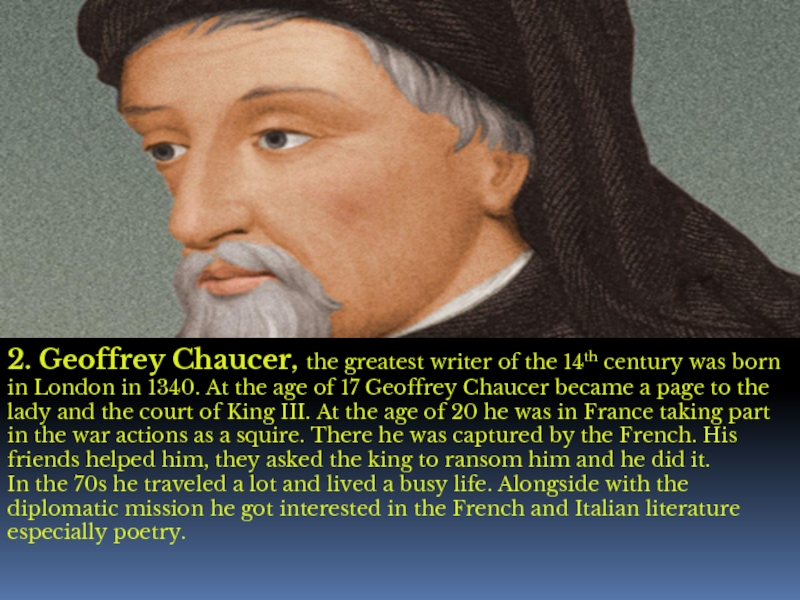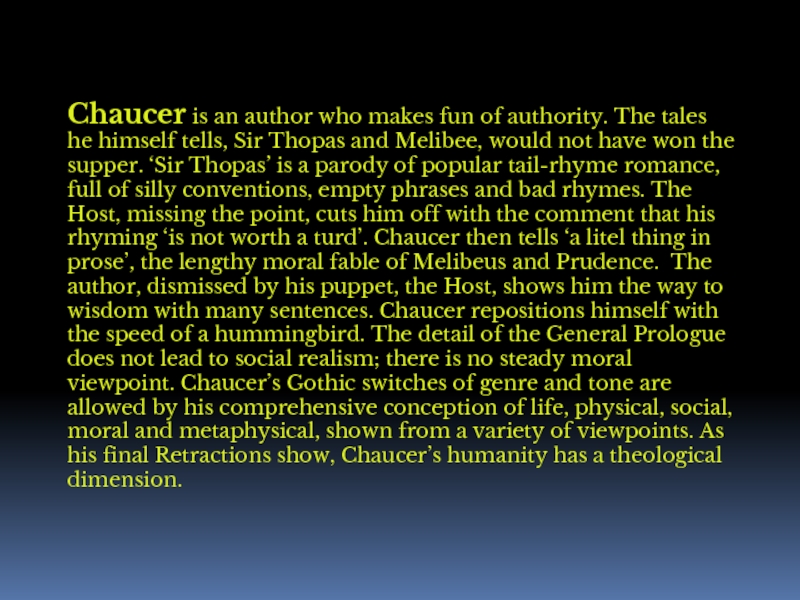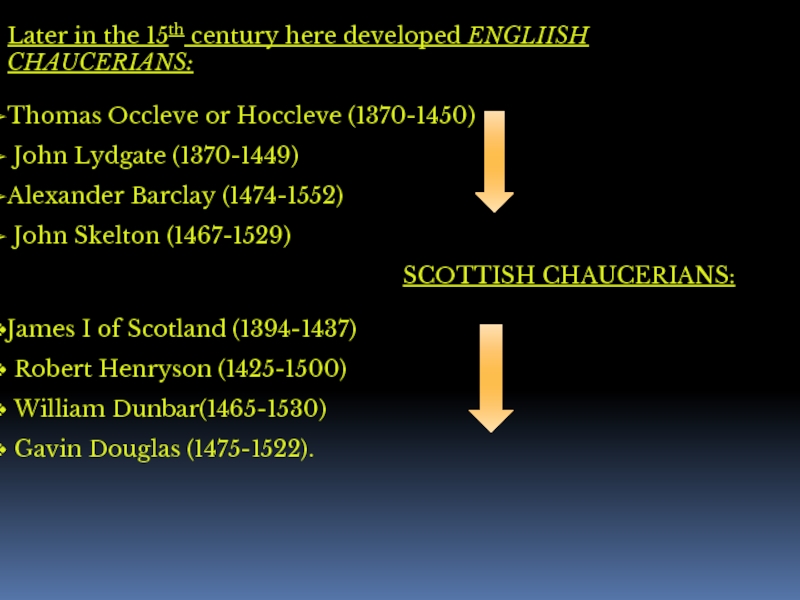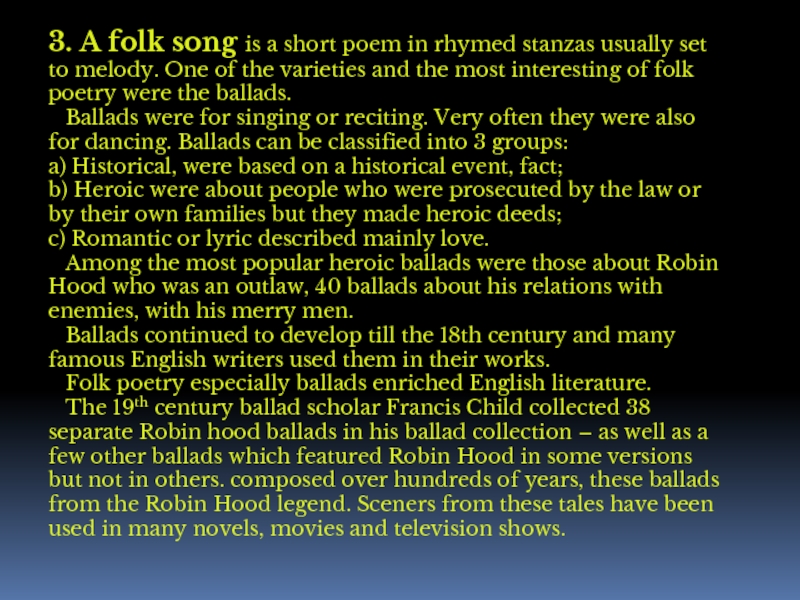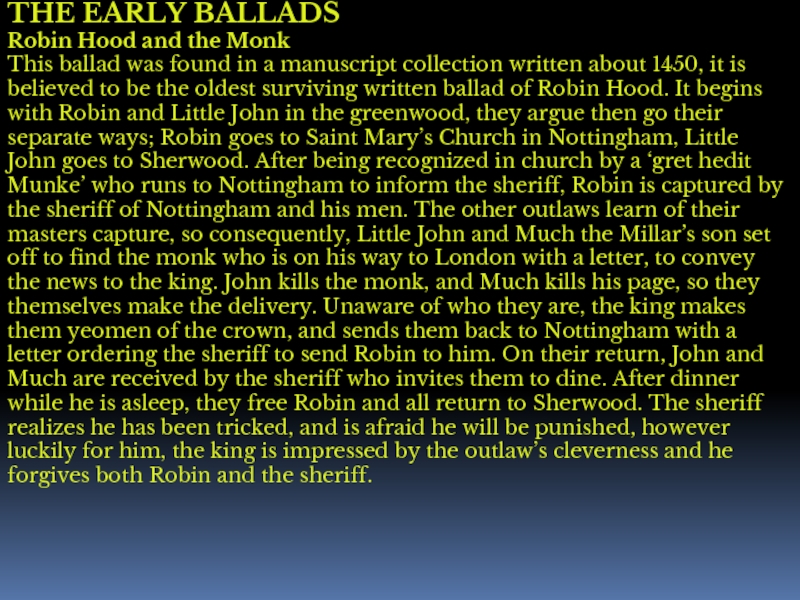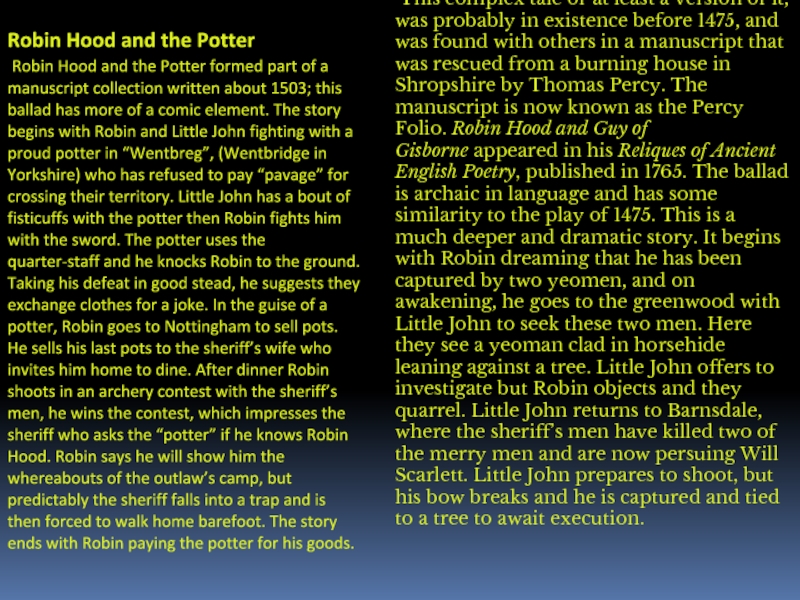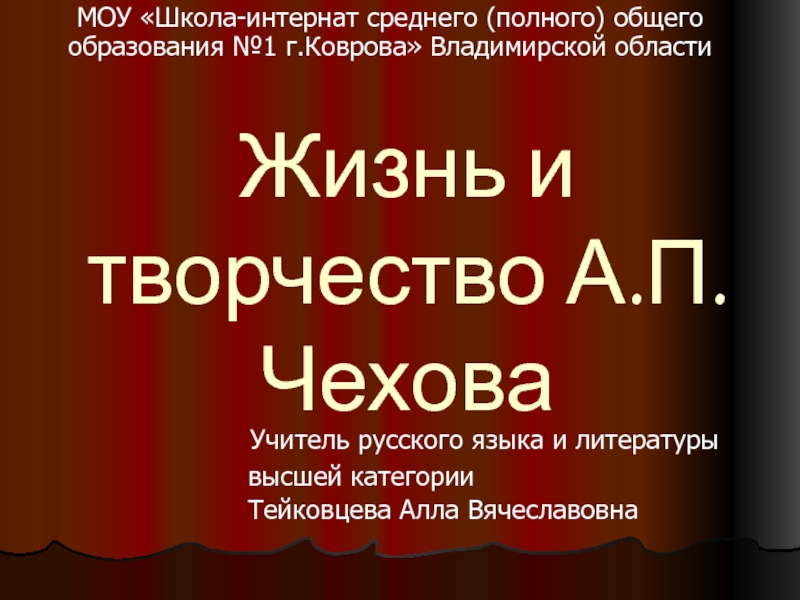- Главная
- Разное
- Дизайн
- Бизнес и предпринимательство
- Аналитика
- Образование
- Развлечения
- Красота и здоровье
- Финансы
- Государство
- Путешествия
- Спорт
- Недвижимость
- Армия
- Графика
- Культурология
- Еда и кулинария
- Лингвистика
- Английский язык
- Астрономия
- Алгебра
- Биология
- География
- Детские презентации
- Информатика
- История
- Литература
- Маркетинг
- Математика
- Медицина
- Менеджмент
- Музыка
- МХК
- Немецкий язык
- ОБЖ
- Обществознание
- Окружающий мир
- Педагогика
- Русский язык
- Технология
- Физика
- Философия
- Химия
- Шаблоны, картинки для презентаций
- Экология
- Экономика
- Юриспруденция
English literature of the middle centuries презентация
Содержание
- 1. English literature of the middle centuries
- 4. 1.1 The Normans The Normans
- 6. 1.2 The union of the races and
- 7. 1.3 The English literature as a part
- 9. 2. Geoffrey Chaucer, the greatest writer of
- 10. Chronology of Chaucer’s works: 1368-72 The Book
- 11. At the early period of his creative
- 13. Chaucer is an author who makes fun
- 14. Later in the 15th century here developed
- 15. 3. A folk song is a short
- 16. THE EARLY BALLADS Robin Hood and the
- 18. Robin Hood and the Potter Robin Hood
Слайд 2
Plan:
I. Literature of
The Normans
The union of the races and languages. Latin, French, and English
The English literature as a part of general medieval European literature
II. Geoffrey Chaucer (1340-1400) and his famous book “The Canterbury Tales”.
III. Folk songs and ballads.
Слайд 41.1 The Normans
The Normans who conquered England were originally
Normans, fastened themselves as settlers, early in the eleventh century, on the northern shore of France, and in return for their acceptance of Christianity and acknowledgment of the nominal feudal sovereignty of the French king were recognized as rightful possessors of the large province which thus came to bear the name of Normandy. Here by intermarriage with the native women they rapidly developed into a race which while retaining all their original courage and enterprise took on also, together with the French language, the French intellectual brilliancy and flexibility
Слайд 61.2 The union of the races and languages. Latin, French, and
In language and literature the most general immediate result of the Conquest was to make of England a trilingual country, where Latin, French, and Anglo-Saxon were spoken separately side by side. With Latin, the tongue of the Church and of scholars, the Norman clergy were much more thoroughly familiar than the Saxon priests had been; and the introduction of the richer Latin culture resulted, in the latter half of the twelfth century, at the court of Henry II, in a brilliant outburst of Latin literature. In England, as well as in the rest of Western Europe, Latin long continued to be the language of religious and learned writing--down to the sixteenth century or even later. French, that dialect of it which was spoken by the Normans--Anglo-French (English-French) it has naturally come to be called--was of course introduced by the Conquest as the language of the governing and upper social class, and in it also during the next three or four centuries a considerable body of literature was produced. Anglo-Saxon, which we may now term English, remained inevitably as the language of the subject race, but their literature was at first crushed down into insignificance.
Слайд 71.3 The English literature as a part of general medieval European
The Norman conquest had a considerable effect on English literature. Before this period English literature was mainly characterized by homilies, religious verses, translations of psalms, parts of Bibles, lives of the saints, rules for an honest religious life, prayers. It was only strongly-religious literature, on the other hand it was deductive literature.
There were, however, exceptional authors, genuine artists, masters of meter and narrative, possessed by a true feeling for beauty; and in some of romances the psychological analysis of love, in particular, is subtile and powerful, the direct precursor of one of the main developments in modern fiction. The romances may very roughly be grouped into four great classes.
The main characters of this genre unlike the characters of church were not saints, but human beings. The worship of fair ladies motivated the plot of these stories.
King Arthur was historical figure, the national hero of Celts. He was described as an ideal king, possessing all virtues of a hero. He was honest, wise, fair to all his vassals. They had their meetings at a round table which Arthur built for their feasts, so that all of them should be equal, consequently this notion has come to our days.
This period was also known as the period of such new genre as fable and fabliau. Fables were short stories with animals for characters and conveying a moral. Fabliau was a short funny story with man, people (cunning, sly, stupid husband, unfaithful wives). They didn’t idealize, but showed practical attitude to life, they were humorous, ironic and slightly deductive.
Слайд 92. Geoffrey Chaucer, the greatest writer of the 14th century was
In the 70s he traveled a lot and lived a busy life. Alongside with the diplomatic mission he got interested in the French and Italian literature especially poetry.
Слайд 10Chronology of Chaucer’s works:
1368-72 The Book of the Duchess
before 1372 The
1378-83TheHouse of Fame
1380-2 The Parlement of Fowls
1382-6 Boece and Troilus and Criseyde
1380-7 Palamon and Arcite
c.1387 The Legend of Good Women
1388-1400 The Canterbury Tales
Слайд 11At the early period of his creative activity he translated French
The 2nd period reveals the Italian influence of Dante. During this period he wrote “The house of Fame”, a deductive poem, presented in allegorical form, which criticized English parliament.
“Troyles and Criseyde” based on an ancient myth about love of two lovers.
The 3rd period – the most important one begins in 1384 when he began writing his masterpiece “The Canterbury Tales” in which he showed various ranks of the contemporary society and summed up the literary genres existed at that time. This book presents a series of stories written in verse.
The characters of the book include a knight, a monk, a student, a miller etc. The most pleasant for the author was the knight who opened the list of pilgrims. The knight possessed bravery, modesty.Every of these characters had to tell a story on the way to Canterbury. By means of different stories Chaucer represented all the literary genres at that time. As for the genres he shows a romance, a moral story, a fable, a fabliau. “The Canterbury Tales” were not finished.In the whole world there are only 12 copies of this book.
He shows the sings of the end of feudalism and the features of the new bourgeois society.Chaucer was a creator of a new literary language, showed the peculiarity of the language in this work. His poetry is rich, lively, and expressive, he created new words which remained to the present time.Chaucer was the earliest English poet, the founder of the English language and literature which is valued today. He is an ironist, not a satirist; his comedy flickers between human sympathy and an absolute morality.
Слайд 13Chaucer is an author who makes fun of authority. The tales
Слайд 14Later in the 15th century here developed ENGLIISH CHAUCERIANS:
Thomas Occleve
John Lydgate (1370-1449)
Alexander Barclay (1474-1552)
John Skelton (1467-1529)
SCOTTISH CHAUCERIANS:
James I of Scotland (1394-1437)
Robert Henryson (1425-1500)
William Dunbar(1465-1530)
Gavin Douglas (1475-1522).
Слайд 153. A folk song is a short poem in rhymed stanzas
Ballads were for singing or reciting. Very often they were also for dancing. Ballads can be classified into 3 groups:
a) Historical, were based on a historical event, fact;
b) Heroic were about people who were prosecuted by the law or by their own families but they made heroic deeds;
c) Romantic or lyric described mainly love.
Among the most popular heroic ballads were those about Robin Hood who was an outlaw, 40 ballads about his relations with enemies, with his merry men.
Ballads continued to develop till the 18th century and many famous English writers used them in their works.
Folk poetry especially ballads enriched English literature.
The 19th century ballad scholar Francis Child collected 38 separate Robin hood ballads in his ballad collection – as well as a few other ballads which featured Robin Hood in some versions but not in others. composed over hundreds of years, these ballads from the Robin Hood legend. Sceners from these tales have been used in many novels, movies and television shows.
Слайд 16THE EARLY BALLADS
Robin Hood and the Monk
This ballad was found in
Слайд 18Robin Hood and the Potter
Robin Hood and the Potter formed part
Robin Hood and Guy of Gisborne
This complex tale or at least a version of it, was probably in existence before 1475, and was found with others in a manuscript that was rescued from a burning house in Shropshire by Thomas Percy. The manuscript is now known as the Percy Folio. Robin Hood and Guy of Gisborne appeared in his Reliques of Ancient English Poetry, published in 1765. The ballad is archaic in language and has some similarity to the play of 1475. This is a much deeper and dramatic story. It begins with Robin dreaming that he has been captured by two yeomen, and on awakening, he goes to the greenwood with Little John to seek these two men. Here they see a yeoman clad in horsehide leaning against a tree. Little John offers to investigate but Robin objects and they quarrel. Little John returns to Barnsdale, where the sheriff’s men have killed two of the merry men and are now persuing Will Scarlett. Little John prepares to shoot, but his bow breaks and he is captured and tied to a tree to await execution.
